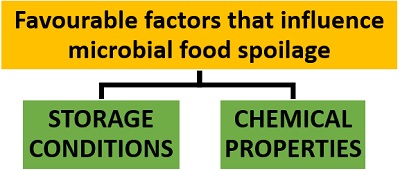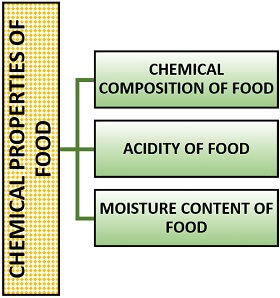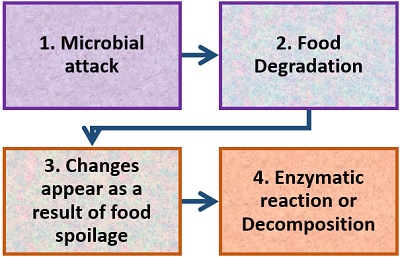The microbial food spoilage is defined as the contamination of food by the growth and enzymatic activity of microorganisms. Food spoilage is the process, in which the quality of the food deteriorates to some extent that renders food unacceptable for human consumption. Food spoilage occurs due to the microbial attack, enzymatic digestion, chemical degradation, physical injury etc. The microbial food spoilage can be determined physically by the following changes:
- Change in appearance: It is characterized by the cloudiness and liquid formation in the food.
- Change in texture occurs due to an accumulation of microbial cells and tissue degradation resulting in slime formation and rotting.
- Colour change: It mainly occurs due to the chlorophyll breakdown and mycelial growth.
- Change in taste and odour: The taste and odour of the food changes due to the oxidation of nitrogenous compounds, sulphides, organic acids etc. by the microbial enzymes.
Microorganisms like bacteria, yeasts and moulds primarily cause food spoilage. Food serves as a good growth medium and contains proteins, carbohydrates and lipids that are utilized by the microorganisms residing in the food. The degradation of food material typically involves hydrolysis of proteins (putrefaction) via proteolytic microorganisms, undesired fermentation through saccharolytic microorganisms and rancidity by the lipolytic microbes. In this post, you will get to know the definition, causes and the mechanism of microbial food spoilage along with the microorganisms involved in the food.
Content: Microbial Food Spoilage
- Definition of Microbial Food Spoilage
- Causes of Microbial Food Spoilage
- Classification of Food
- Microorganisms Involved in Food Spoilage
- The Process of Microbial Food Spoilage
- Conclusion
Definition of Microbial Food Spoilage
Microbial food spoilage is the biological process that causes degradation or decomposition of the food item due to microbial growth and activity that brings undesirable changes and makes the food undesirable for consumption. It primarily depends upon the two factors, namely food matrix (physical and chemical properties of food), the type of microorganisms and the storage conditions. Food spoilage merely refers to the physical state where it does not meet the quality characteristics. Microbial food spoilage can be controlled by subjecting the food under refrigeration, lyophilization and by adding preservatives.
Causes of Microbial Food Spoilage
Two common factors favour the growth and multiplication of microorganisms:

Storage Conditions of the Food
The storage conditions basically involve environmental factors like temperature, pH and oxygen that favours the microbial growth.
Temperature: The psychrophilic temperature, i.e. -17, is considered to be safe, and it can prevent the growth of microorganisms. The temperature above this is called mesophilic temperature that is the most favourable for the microbial growth. The mesophilic temperature is in between 20-40 degrees Celsius. Therefore, the warm temperature is optimal for microbial growth like mesophilic and thermophilic microorganisms.
Oxygen: There are aerobic and anaerobic microorganisms that attack the food in storage conditions in the presence or absence of oxygen, respectively. Aerobic storage conditions favour the aerobic bacteria and moulds. If there are anaerobic storage conditions, it will favour anaerobic bacteria like Clostridium species.
Chemical Properties of the Food
The food spoilage is caused due to the degradation of the food components by the microorganisms’ enzymatic activity. The chemical properties of the food that influence microbial growth includes:

The chemical composition of the food
In food, certain organic biomolecules like protein, carbohydrates and fats are necessary for the microbial growth.
Protein-rich foods: In protein-rich foods, the microorganisms which attack are called proteolytic microorganisms. The proteolytic enzyme causes the degradation of protein into simpler forms like amino acids, amines etc.

The proteolytic microorganisms include gram-negative, spore-forming bacteria.
Carbohydrate-rich foods: In carbohydrate-rich foods, the microorganisms which attack are called carbohydrate fermenting microorganisms. Carbohydrate fermenting microorganisms causes the degradation of carbohydrate into the fermentative products by producing acids, alcohols and gases.

The carbohydrate fermenting microorganisms include yeast, moulds and bacteria (Micrococcus sp., Streptococcus sp. etc.).
Fat rich foods: In fat-rich foods, the microorganisms which attack are called lipolytic microorganisms. Lipolytic enzymes cause the degradation of fat into simpler forms like fatty acids, glycerol etc.

The lipolytic microorganisms include moulds and some gram-negative bacteria.
The acidity of the food
The pH below 4.5 does not allow the subsequent bacterial growth, but favour yeasts and moulds that mainly affects the acidic food items (like citrus fruits and vegetables). The high pH favours the bacterial growth that predominantly affects the non-acidic foods.
Moisture and osmotic concentration of food
In food, 13% of the free water favours microbial growth. High sugar and salt concentration prevent microbial growth. For the growth of moulds, the required sugar concentration is 65-70%. For the growth of yeasts and bacteria, the required sugar concentration is 50%.
Classification of Food
The food is classified into three types based on the spoilage:

- Non-perishable food has no water content, and it can be stored for a long time. These have a long shelf life.
- Semi-perishable food has less water content, and it can be stored for some time. These have a medium shelf life.
- Perishable food has high water content, and it cannot store for a longer period. These have a short shelf life.
The high water or moisture content is a factor that directly influences microbial growth, as water promotes the growth of all living beings. Therefore, the food which is susceptible to the spoilage process called perishable food.
Microorganisms Involved in Food Spoilage
There are commonly three kinds of microorganisms, which causes food spoilage:
Yeasts: These are the type of fungi that are single-celled and cause fermentation of food. Yeasts are of two types, namely true yeasts and false yeasts. The favourable conditions for the yeasts to cause food spoilage are low pH and low moisture. True yeasts convert sugar into alcohol and carbon dioxide. False yeasts grow on the food surface as a dry film.
Mould: It is another type of fungi, which are multicellular and produce a tough visible mass on the food surface called mycelium. Moulds are aerobic organisms that require oxygen to grow, slightly acidic conditions, moisture, a temperature of 20-40 degrees Celsius. It mostly affects food items like bread, cheese, meat etc.
Bacteria: These are the organisms that cause food spoilage at low moisture, warm environment (5-60 degrees Celsius), neutral acidity and in the presence of oxygen.
The Process of Microbial Food Spoilage
Microbial food spoilage can be summarized into the following steps:

- Microbes first attack the food: As the food contain all the nutrients required by the microorganisms, at a favourable temperature, pH, moisture, oxygen etc.
- Food degradation: Microorganisms degrades the food material by utilizing the nutrients available in the food and decompose the food material.
- Decomposition: The enzymatic reaction occurs between the food components like protein, lipid, fat, carbohydrates etc., and the microbial enzymes carry out some chemical changes.
- Changes as a result of food decomposition: The changes appear in the form of appearance, texture, colour, taste, odour etc. as a result of spoilage.
Conclusion
Therefore, we can conclude that the microorganisms’ growth and activity cause food spoilage that imposes some undesirable changes in the colour, texture, taste, and smell of the food item and called microbial food spoilage.
Give detlias of vermi compost business plan